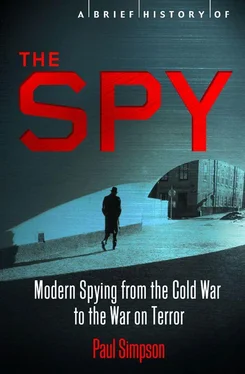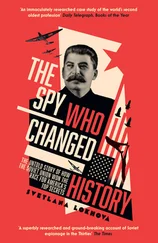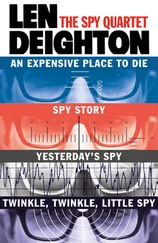Paul Simpson - A Brief History of the Spy
Здесь есть возможность читать онлайн «Paul Simpson - A Brief History of the Spy» весь текст электронной книги совершенно бесплатно (целиком полную версию без сокращений). В некоторых случаях можно слушать аудио, скачать через торрент в формате fb2 и присутствует краткое содержание. Город: London, Год выпуска: 2013, ISBN: 2013, Издательство: Constable & Robinson, Жанр: Прочая документальная литература, на английском языке. Описание произведения, (предисловие) а так же отзывы посетителей доступны на портале библиотеки ЛибКат.
- Название:A Brief History of the Spy
- Автор:
- Издательство:Constable & Robinson
- Жанр:
- Год:2013
- Город:London
- ISBN:9781780338910
- Рейтинг книги:3 / 5. Голосов: 1
-
Избранное:Добавить в избранное
- Отзывы:
-
Ваша оценка:
- 60
- 1
- 2
- 3
- 4
- 5
A Brief History of the Spy: краткое содержание, описание и аннотация
Предлагаем к чтению аннотацию, описание, краткое содержание или предисловие (зависит от того, что написал сам автор книги «A Brief History of the Spy»). Если вы не нашли необходимую информацию о книге — напишите в комментариях, мы постараемся отыскать её.
A Brief History of the Spy — читать онлайн бесплатно полную книгу (весь текст) целиком
Ниже представлен текст книги, разбитый по страницам. Система сохранения места последней прочитанной страницы, позволяет с удобством читать онлайн бесплатно книгу «A Brief History of the Spy», без необходимости каждый раз заново искать на чём Вы остановились. Поставьте закладку, и сможете в любой момент перейти на страницу, на которой закончили чтение.
Интервал:
Закладка:
There was little time for congratulation though, since Gordievsky had been reporting that Operation Ryan was reaching a peak. In February 1983, KGB staff had been given twenty tasks to monitor British preparations, which included whether the price paid to blood donors had increased (they’re actually unpaid), and how many lights were being left on at night in government buildings. In August, further tasks were added.
The relationship between East and West seriously faltered after the Soviets shot down a civilian 747, Korean Airlines flight KAL 007, on 1 September 1983, killing all 269 people aboard, including US Congressman Lawrence McDonald. The NSA radio facility at Hokkaido in Japan intercepted the transmission from fighter pilot Major Osipovich stating, ‘I have executed the launch… the target is destroyed.’ This recording was released to the public, ratcheting up the rhetoric.
However, this intercept only told part of the story. When the entire conversation was reviewed, it showed that the Soviets thought that they were tracking an American RC-135 reconnaissance aircraft, not a Boeing 747, and that the Korean pilots hadn’t responded to tracer bullets fired in front of the airplane. President Reagan went on US television on 5 September to accuse the Soviets of a crime against humanity. The next day the US ambassador to the UN, Jeanne Kirkpatrick, accused them of mass murder. The dispute overshadowed a meeting of foreign ministers in Madrid on 8 September, with Andrei Gromyko suggesting ‘the world situation is now slipping towards a very dangerous precipice’. On 28 September, Yuri Andropov gave a speech from his sick bed that accused the Reagan administration of ‘imperial ambitions’ and wondered ‘whether Washington has any brakes at all preventing it from crossing the point at which any sober-minded person must stop’.
Their fear was magnified by the NATO exercise ABLE ARCHER 83, which was held between 2 and 11 November. Its stated aim was to practise nuclear-release procedures, but the Soviets genuinely believed that it would be used as a cover for a real first strike. According to Sir Geoffrey Howe, then British Foreign Secretary, Gordievsky ‘left us in no doubt of the extraordinary but genuine Russian fear of real-life nuclear strike’. It was clearly time to tone down the rhetoric: reassuring signals were sent by Washington and London to Moscow. Yuri Andropov’s death in February 1984 no doubt helped alleviate the tension (his successor, Chernenko, wasn’t quite so paranoid about a first-strike).
The publicity given to the KGB resident Arkadi Guk as a result of Bettany’s trial in 1984 gave MI5 the excuse to declare him persona non grata, and aid Gordievsky’s elevation a stage further (the downside was that the British head of station in Moscow was kicked out from the Soviet Union). Gordievsky continued to pass information through to MI6, assisting with Margaret Thatcher’s preparations for Mikhail Gorbachev’s visit to Britain at the end of the year. It seemed as if Gordievsky’s star was still in the ascendant, particularly when the KGB decided to appoint him as Guk’s successor in January 1985. However, his luck was about to run out.
While much of the free world’s intelligence agencies were concentrating on the heightened level of Soviet activity, the Australian Secret Intelligence Service found themselves once more the subject of some unwanted publicity.
On 11 November 1983, the final day of ABLE ARCHER 83, the ASIS began training a team in various elements of tradecraft, including close-quarters combat, surveillance, medical skills and methods for illegal entry. As an exercise, the team were instructed to carry out an armed rescue of a supposed defector, John, and his brother Michael. It all went badly wrong, ending up in an operation that was described in an official report as ‘poorly planned, poorly prepared and poorly coordinated’.
To begin with, guns were removed from a secret armoury without authorization. Then the trainees lost contact with John and the supposed foreign agents with whom he was consorting. They had to be told to go to the upmarket Sheraton Hotel in Melbourne, where they exceeded their instructions by using a sledgehammer to break down the door of the room in which John and his colleagues were meeting. When the hotel manager, Nick Rice, investigated, the trainees’ team leader got in a fight with him in the elevator — whereupon Rice called the police. The team leader then released the supposed foreign agents, who had been handcuffed as part of the exercise, and raced to meet the rest of his team who were ‘abducting’ John from the hotel. The Sheraton staff were not impressed, and although the trainees and John claimed they were from ASIS, took the car licence number and reported it. Police stopped the car and arrested the occupants.
The resultant publicity led to local paper the Sunday Age revealing the names of five of the agents involved in an article headlined ‘The Sheraton Shambles’, which provoked a court case over whether the government had the right to release agents’ names (it was effectively agreed that they did indeed have the right, but shouldn’t exercise it). ASIS Director-General John Ryan refused to cooperate with the police enquiry, but he resigned after being held responsible by a Royal Commission for authorizing the operation. In the end, no charges were brought against any of the agents. The Federal government paid over A$300,000 in settlement to the Sheraton and its staff.
The Australians weren’t the only ones to bungle during this time. The case of Richard Miller once again demonstrated that not everything in the spy world goes according to plan.
Miller has the distinction of being the first KGB spy to be caught within the FBI, and possibly the most incompetent agent within either agency. He joined the Bureau in the early sixties, and quickly gained a poor reputation, trying to obtain goods from stores by showing his FBI badge, and even stealing and selling information from the Bureau on behalf of a local private investigator. According to a scything attack on the FBI in Washington Monthly in 1989, by 1982, Miller had ‘a personnel file filled with doubts about his job performance… A psychologist examined Miller and told the FBI that he was emotionally unstable and should be nurtured along in some harmless post until retirement.’
This harmless post turned out to be with the counter- intelligence unit in Los Angeles, where in 1984 he came to the attention of low-level KGB agent Svetlana Ogorodnikova, a Russian émigré. Miller was seduced and asked to find out the location of Soviet defector Stanislav Levchenko. This he was unable to do, but he did pass across an FBI manual stating the sorts of intelligence that the Bureau was looking for. Ogorodnikova was known to the FBI, and they began watching Miller to see if there was potential to use him as a double agent.
That October, Ogorodnikova wanted Miller to travel to Europe with her, to meet with her KGB superiors, and at this point Miller approached his superiors, saying he was trying to infiltrate the Soviet network. The Bureau believed that he only did this because he had spotted the surveillance, and fired him — then arrested him for espionage, as well as Ogorodnikova and her husband. They pleaded guilty to conspiracy to commit espionage; Ogorodnikova was sentenced to eighteen years in prison, her husband to eight. Miller claimed he was working on behalf of the Bureau to penetrate the spy ring; the jury disbelieved him and he was sentenced to two consecutive life terms. A mistrial was declared on technical grounds and at a second trial in 1990, he was found guilty again and sentenced to twenty years, reduced to thirteen. Ogorodnikova spent years battling deportation to Russia before escaping to Mexico with a new husband.
Читать дальшеИнтервал:
Закладка:
Похожие книги на «A Brief History of the Spy»
Представляем Вашему вниманию похожие книги на «A Brief History of the Spy» списком для выбора. Мы отобрали схожую по названию и смыслу литературу в надежде предоставить читателям больше вариантов отыскать новые, интересные, ещё непрочитанные произведения.
Обсуждение, отзывы о книге «A Brief History of the Spy» и просто собственные мнения читателей. Оставьте ваши комментарии, напишите, что Вы думаете о произведении, его смысле или главных героях. Укажите что конкретно понравилось, а что нет, и почему Вы так считаете.












